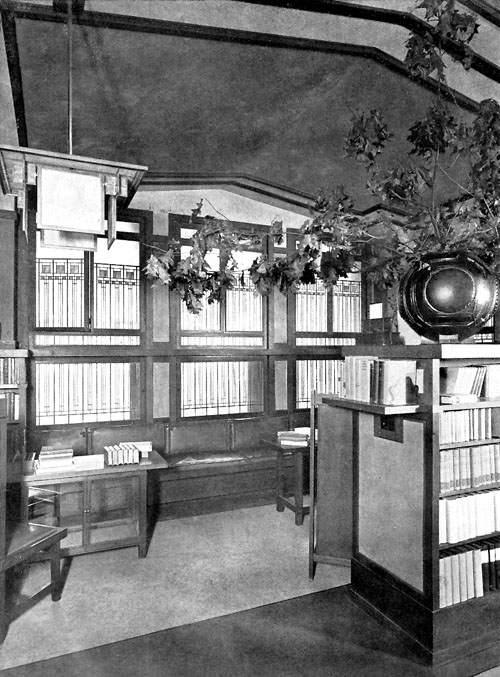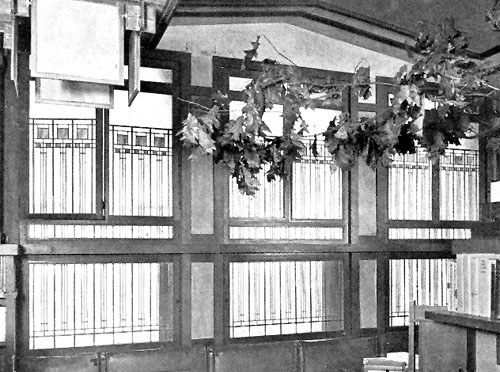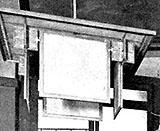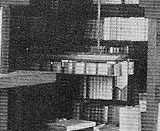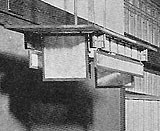|
|
WRIGHT STUDY
Browne's
Bookstore, Chicago (1907 - S.141) |
|
|
|
Art Glass Windows
Browne's and Wright's Playroom
Art Glass Fixtures
|
|
|
|
Art Glass Windows |
|
|
|
|
|
Every fixture and piece of
furniture in both rooms were specially designed by Wright and
manufactured to order. The cases, tables, chairs, and wall
trimmings are of quartered oak throughout. This also
included the art glass and light fixtures. There are three
examples of the art glass windows in Browne's Bookstore. The
first example is in the seating cove looking out over Lake
Michigan, image #3. Wright utilized the
three existing sets of windows, each set consisting of seven
repeated vertical designs. In each set, Wright continued the
design from glass panel to glass panel, |
|
even allowing sections to open. The second example
is on the opposite end of the long room seen in
image #5. This window consisting of
fourteen repeated vertical designs. The third example is in the
smaller room. Two upper clerestory windows are visible in
image #6. This window appears to consist
of eight repeated vertical designs, and continue below the
horizontal trim. This window design was
reminiscent of the windows Wright designed a few years
earlier for the Unity Temple
(1904 - S.096). |
| |
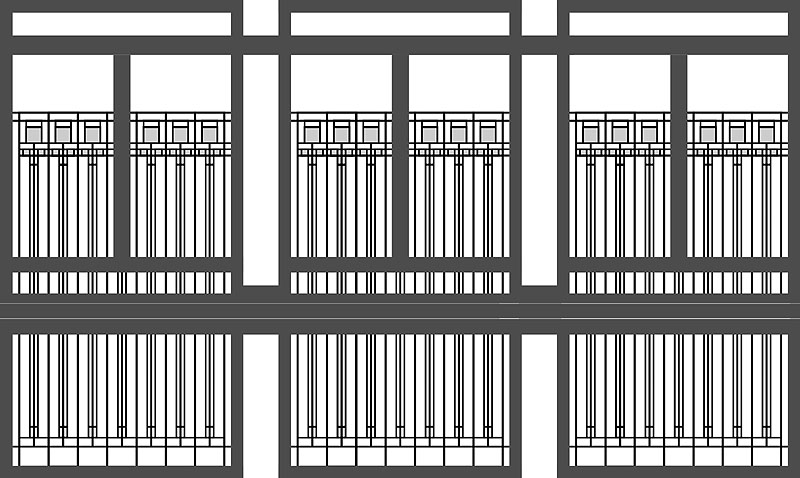 |
| 2:
Adaptation of image #3. Wright utilized the three existing
sets of windows, each set consisting of seven repeated
vertical designs. In each set, Wright continued the design
from glass panel to glass panel, even allowing sections to
open. This window design was
reminiscent of the windows Wright designed a few years
earlier for the Unity Temple
(1904 - S.096). Illustration Copyright 2011, Douglas M. Steiner. |
|
|
|
Int5 |
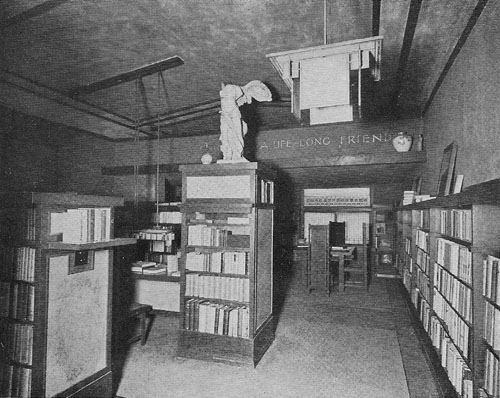 |
| 3a: The
second example is on the opposite end of the long room seen
in image #5. This window consisting of fourteen repeated
vertical designs. |
| |
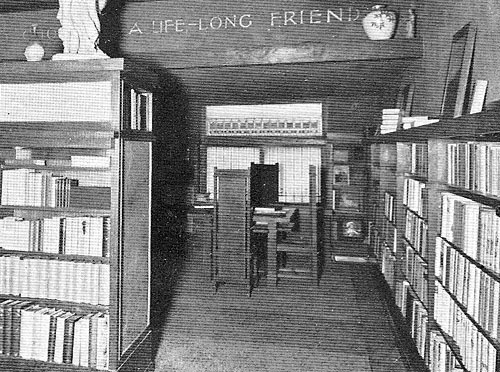 |
| 3b: Detail
of mage #5. This window consisting of fourteen repeated
vertical designs. |
|
Int6 |
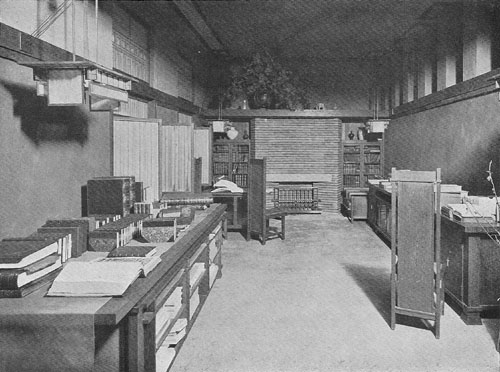 |
|
4a: The third example is in the
smaller room. Two upper clerestory windows are visible in
image #6 on the upper left. This window appears to consist
of eight repeated vertical designs, and continue below the
horizontal trim. |
| |
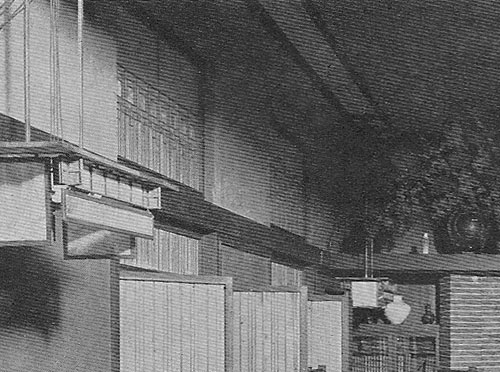 |
| 4b: Detail
of mage #6. Two upper clerestory windows are visible
on the upper left. This window appears to consist of eight
repeated vertical designs, and continue below the horizontal
trim. |
| |
| |
| |
|
Browne's Bookstore and Wright's Oak Park
Playroom |
|
|
|
|
|
In
1895 Wright added a
second story playroom to his home in Oak Park. The original
windows, are similar in design to the Winslow Residence
(1894 - S.024), but are of a simpler more geometric nature.
See "Stained Glass"
Heinz p45.
The original 1895 window design included built-in window
seating. In 1911, Wright completed an
extensive renovation and remodel of the Home and Studio. The
window seating was removed, and the windows were replaced
with a new design that nearly matches the design from
Browne's |
|
Bookstore. When you look at the
time line, the bookstore opened in late 1907. By the end of
1910 to the early part of 1911, the bookstore abandoned the
seventh floor for space on the street level. Wright's
renovation to the playroom was completed in 1911. This begs
the question. Did Wright salvage the windows and utilize
parts of the windows for the playroom, or did he utilize
just the design? Either way, the design in the playroom is
strikingly similar to the design of the Bookstore windows. |
| |
|
|
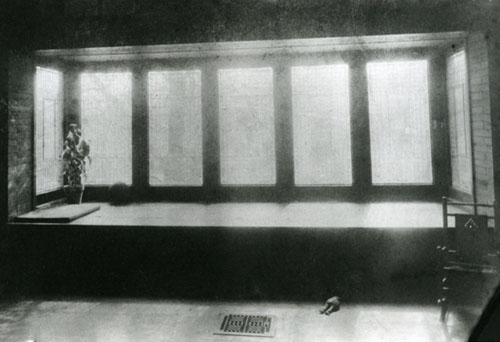 |
| 5a:
Original windows in the Oak Park Home Playroom, circa 1895.
Note the built in window seating (later removed), the ball
to the center left, and the doll on the floor. Cute. Courtesy of the Frank Lloyd Wright Preservation Trust. |
| |
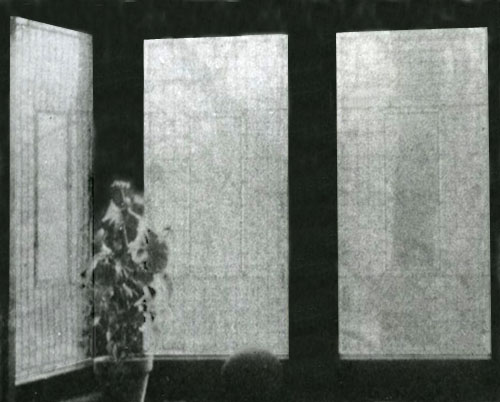 |
| 5b: Detail
of the original windows in the Oak Park Home Playroom, Circa
1895. See "Stained Glass"
Heinz p43, for an additional example. This design is similar
to the design for the
Winslow Residence p45
(1894 - S.024), but of a simpler more geometric nature.
Image enhanced by Douglas M. Steiner. |
|
OP1911 |
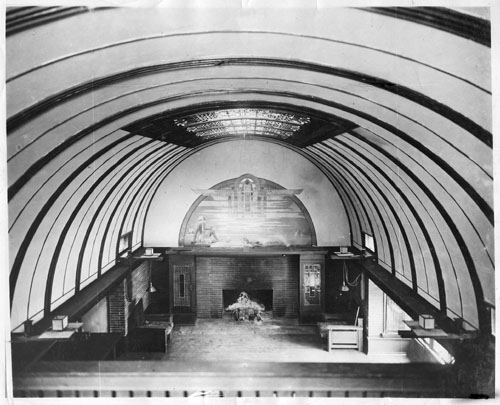 |
| 6a: Oak
Park Home Playroom, Circa 1910-11, after an extensive
renovation and remodel. Note the removal of window seating
and the new window design. See detail below.
For additional
information concerning this image. |
| |
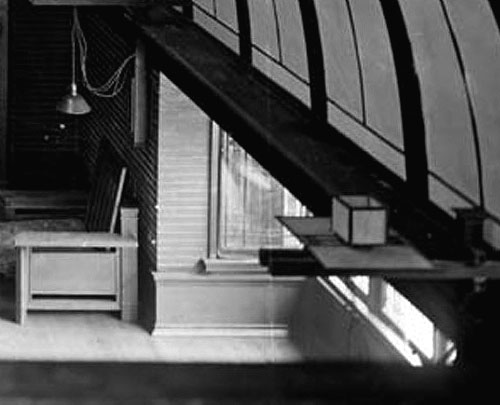 |
| 6b: Detail
of the Oak Park Home Playroom, Circa 1910-11. This image
shows the change to the windows, and the removal of the window
seating. |
| |
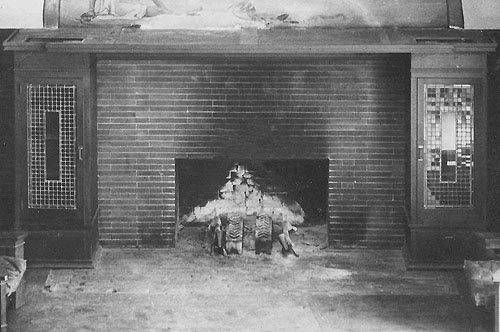 |
| 6c: Detail
of the Oak Park Home Playroom, Circa 1910-11. Also of
interest is the addition of the cabinets on either side of
the fireplace. These two cabinets appeared in photographs
dating 1910-1911, and were not seen in earlier images. See
image below (7). Although the playroom windows were changed,
the cabinet glass was not. The design is the same but
dimensions differ slightly from the earlier windows. In
these glass doors the large center rectangle is longer than
the original windows. There are three rows of seventeen
squares on either side of the larger rectangle in these
glass doors versus approximately fourteen squares in the
windows. |
| |
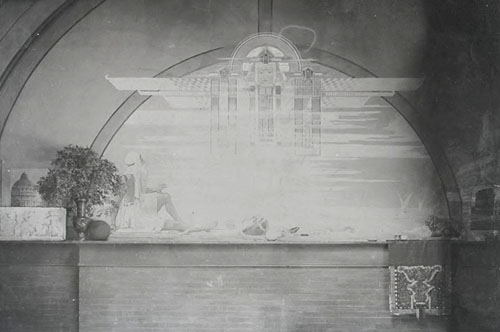 |
| 7:
Oak Park Home Playroom, dated 1895-1910 by the Frank Lloyd
Wright Preservation Trust. Courtesy of the Frank Lloyd Wright Preservation Trust. |
| |
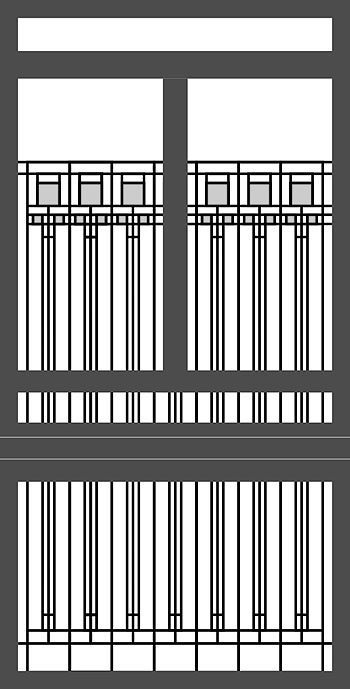 |
|
|
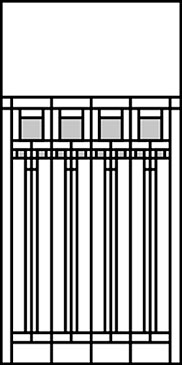
Left - 8a:
Browne's Bookstore. Adaptation of image #3. Each set consisting of seven repeated
vertical designs. Wright continued the design
from glass panel to glass panel, even allowing sections to
open.
Top - 8b: Detail
of the Oak Park Home Playroom Window, Circa 1910-11. When
placed side by side the similarities are striking. |
| Illustrations
Copyright 2011, Douglas M. Steiner. |
|
| |
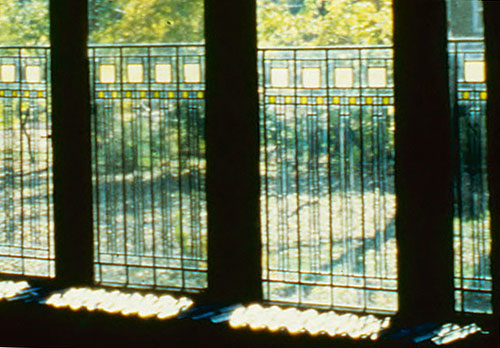 |
| 9: Detail
of the Oak Park Home Playroom Window, 1986. Courtesy of the
Frank Lloyd Wright Preservation Trust. |
| |
| |
| |
|
|
|
Browne's Bookstore Art Glass Fixtures |
|
|
|
|
|
The light
fixtures were uniquely designed by Wright for the bookstore.
Wright would often adapt designs from other projects, but it
does not seem to be true in this case. To date we have not
found a similar fixture designed by Wright. Three different versions of light fixtures
were identified. One square and two rectangle. Version A
is a square fixture. The top is a flat square
surface that extends out equally on all four sides. The four
side pieces are also square, and the four small corner
pieces are made up of two squares that intersect each other.
Globe bulbs are within. Version B on the left in the cove,
and appears to be the clearest image |
|
of this version. It is a rectangle fixture
that is suspended above the table. The sides match the
dimensions of the corner pieces, but run in a parallel line
between the two corners, similar to Version
C. There
appears to be a larger square piece on the end that comes to
point at the bottom center. Version C, top left, is a rectangle fixture
that is suspended. The sides match the
dimensions of the corner pieces, but run in a parallel line
between the two corners, similar to Version
B. A square piece is on either end like Version A. |
| |
|
|
|
|
|
|
 |
|
Version
D: Built-in book shelf lighting. |
|
|
|
Version A |
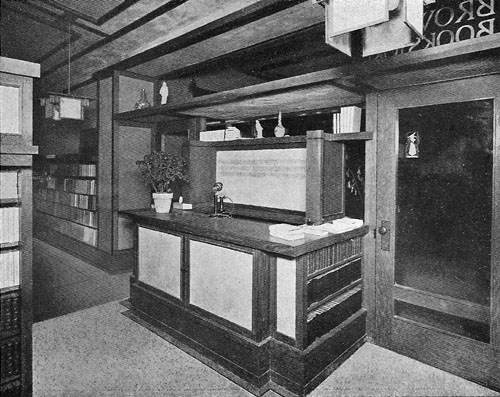 |
|
9a: Image #2 - Interior view of
entry. The cashier's station is conveniently
situated between the two entry doors. Version A
is a square fixture. The top is a flat square
surface that extends out equally on all four sides. The four
side pieces are also square, and the four small corner
pieces are made up of two squares that intersect each other.
Globe bulbs are within. See Image #3 for a better view of
the corner pieces. |
| |
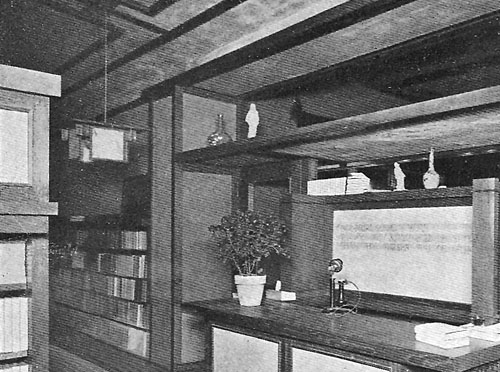 |
|
9b: Detail of Image
#2, the left light fixture. Version A is a square
fixture. The top is a flat square surface that extends out
equally on all four sides. The four side pieces are also
square, and the four small corner pieces are made up of two
squares that intersect each other. Globe bulbs are within.
See Image #3 for a better view of the corner pieces. |
| |
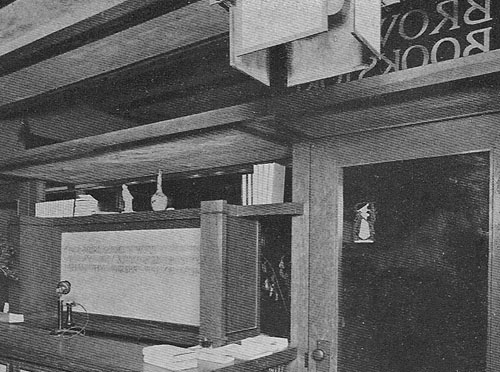 |
|
9c: Detail of Image
#2, the right light fixture. Version A is a
square fixture. The top is a flat square surface that
extends
out equally on all four sides. The four side pieces are also
square, and the four small corner pieces are made up of two
squares that intersect each other. See Image #3 for a better
view of the corner pieces. |
|
Im3 |
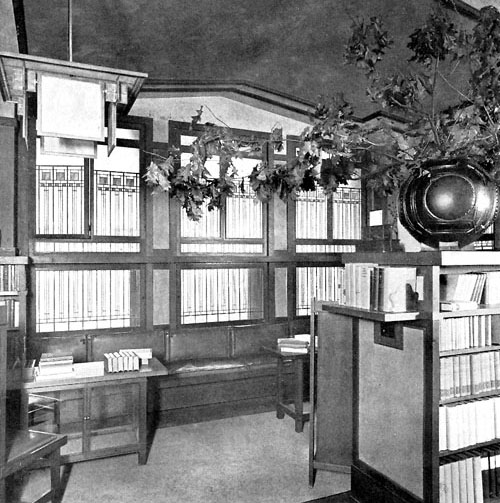 |
|
10a: Image #3 - View of
front Cove. Version A is a square fixture. The
top is a flat square surface that extends out equally on all
four sides. The four side pieces are also square, and the
four small corner pieces are made up of two squares that
intersect each other. Globe bulbs are within. |
| |
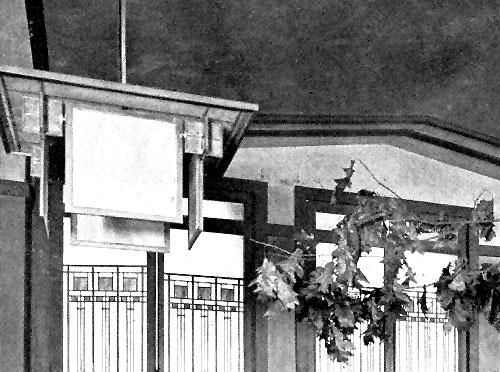 |
|
10b: Detail of Image
#3 - Version A is a square fixture. The
top is a flat square surface that extends out equally on all
four sides. The four side pieces are also square, and the
four small corner pieces are made up of two squares that
intersect each other. Globe bulbs are within. |
| |
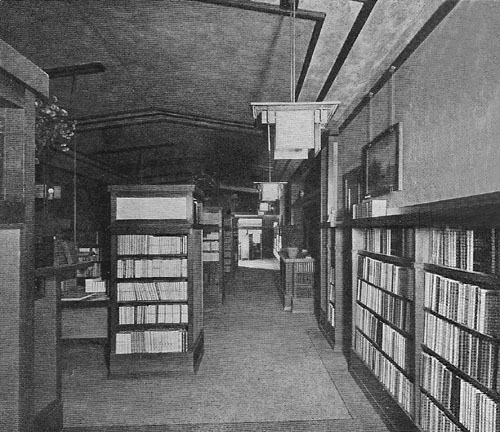 |
|
11a: Image #4: View from front to
back. Alcoves were arranged along the left side;
each alcove had chairs, a table and reading
light. Version A is a square fixture. The top is
a flat square surface that extends out equally on all four
sides. The four side pieces are also square, and the four
small corner pieces are made up of two squares that
intersect each other. |
| |
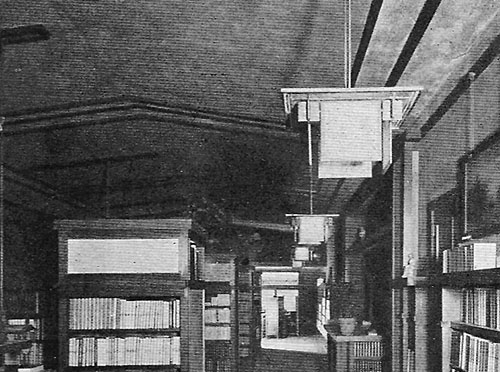 |
|
11b: Detail of Image #4:
Version A is a square fixture. The top is
a flat square surface that extends out equally on all four
sides. The four side pieces are also square, and the four
small corner pieces are made up of two squares that
intersect each other. |
|
|
|
Version B |
 |
|
12a: Image #5: View from entry to back. Alcoves were
arranged along the left side; each alcove had
chairs, a table and reading light. Version A on
the right is a square fixture. The top is a flat square
surface that extends out equally on all four sides. The four
side pieces are also square, and the four small corner
pieces are made up of two squares that intersect each other.
Version B on the left in the cove, and appears to be
the clearest image of this version. It is a rectangle fixture
that is suspended above the table. The sides match the
dimensions of the corner pieces, but run in a parallel line
between the two corners, similar to Version
C. There is a larger pentagon shaped piece on the end that comes to
a point at the bottom center. |
| |
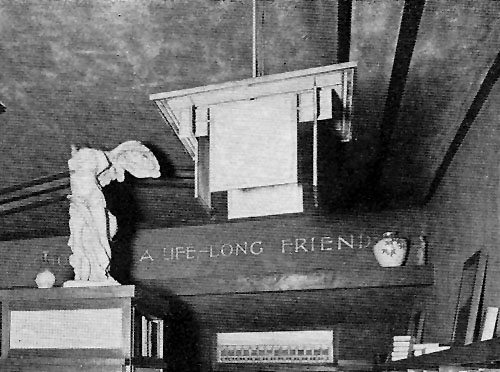 |
|
12b: Detail of Image #5:
Version A on
the right is a square fixture. The top is a flat square
surface that extends out equally on all four sides. The four
side pieces are also square, and the four small corner
pieces are made up of two squares that intersect each other. |
| |
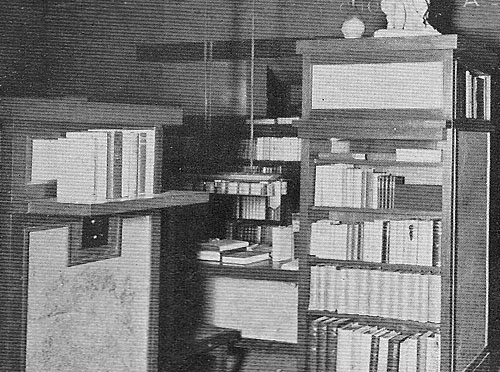 |
|
12c: Detail of Image #5:
Version B on the left in the cove, and appears to be
the clearest image of this version. It is a rectangle fixture
that is suspended above the table. The sides match the
dimensions of the corner pieces, but run in a parallel line
between the two corners, similar to Version
C. There
is a larger pentagon shaped piece on the end that comes to a point at the bottom center. |
|
|
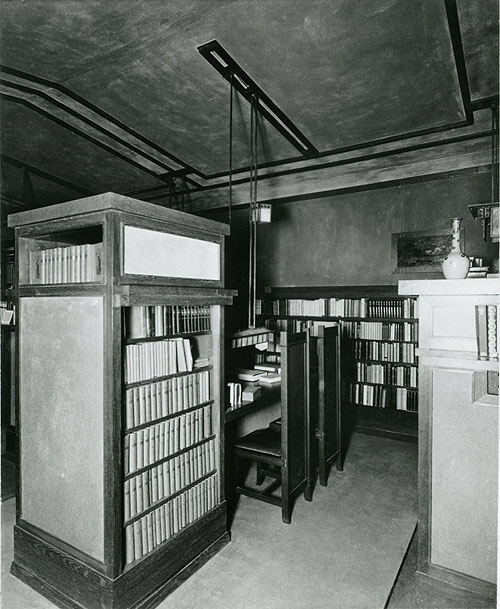 |
|
13a: Image #6: View of
Cove. Each Cove included a built in table, four
high-backed chairs and a reading light. Four
lighting examples are visible, with the possibility
of a fifth. Version A is partially visible
on the top right. Version B in the center, is
hanging above the table. It is a rectangle fixture
that is suspended above the table. The sides match the
dimensions of the corner pieces, but run in a parallel line
between the two corners, similar to Version
C. There is a larger pentagon shaped piece on the end that comes to
a point at the bottom center.
Version D can clearly be seen at the top of
the book shelf pier. Publisher's
Weekly reported "By a unique system of shelf-lighting,
the title of every volume from top shelf to
bottom were easily be read, while at the same
time the lights were hidden from the eye".
The book tier on the left shows the design of
the lighting system just above the top shelf. Not
only were the upper shelves recessed, but the
lower shelves were slightly slanted, angling the
books upward. A fifth version (E) would be the
possible small square fixture attached above Version
B, possibly added at a later time for addition light
in the cove. This image also clearly shows how
fixtures are suspended from the ceiling. |
|
|
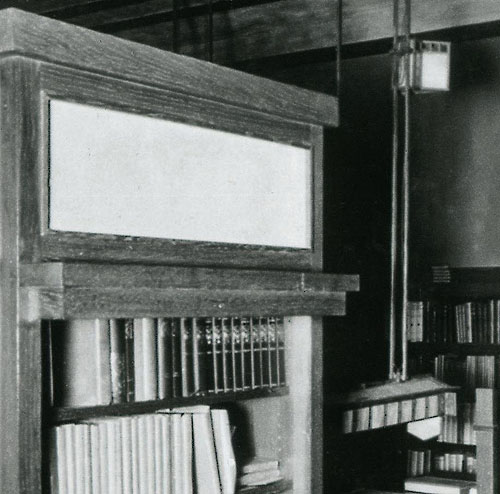 |
|
13b: Detail of Image #6:
View of Cove. Version B in the center, is
hanging above the table. It is a rectangle fixture
that is suspended above the table. The sides match the
dimensions of the corner pieces, but run in a parallel line
between the two corners, similar to Version
C. There is a larger pentagon shaped piece on the end that comes to
a point at the bottom center.
Version D can clearly be seen at the top of
the book shelf pier. Publisher's
Weekly reported "By a unique system of shelf-lighting,
the title of every volume from top shelf to
bottom were easily be read, while at the same
time the lights were hidden from the eye".
The book tier on the left shows the design of
the lighting system just above the top shelf. Not
only were the upper shelves recessed, but the
lower shelves were slightly slanted, angling the
books upward. A fifth version (E) would be the
possible small square fixture attached above Version
B, possibly added at a later time for addition light
in the cove. |
|
|
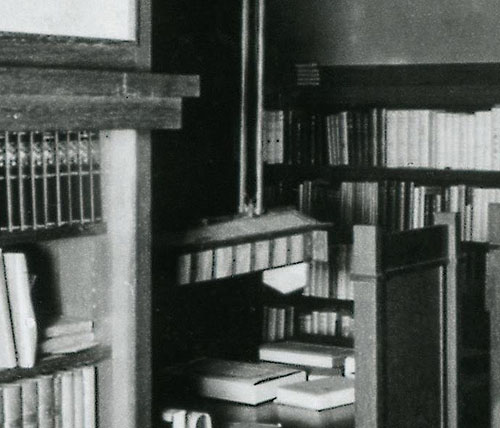 |
|
13c: Detail of Image #6:
View of Cove. Version B in the center, is
hanging above the table. It is a rectangle fixture
that is suspended above the table. The sides match the
dimensions of the corner pieces, but run in a parallel line
between the two corners, similar to Version
C. There is a larger pentagon shaped piece on the end that comes to
a point at the bottom center.
Version D can clearly be seen at the top of
the book shelf pier. Publisher's
Weekly reported "By a unique system of shelf-lighting,
the title of every volume from top shelf to
bottom were easily be read, while at the same
time the lights were hidden from the eye".
The book tier on the left shows the design of
the lighting system just above the top shelf. Not
only were the upper shelves recessed, but the
lower shelves were slightly slanted, angling the
books upward. |
|
|
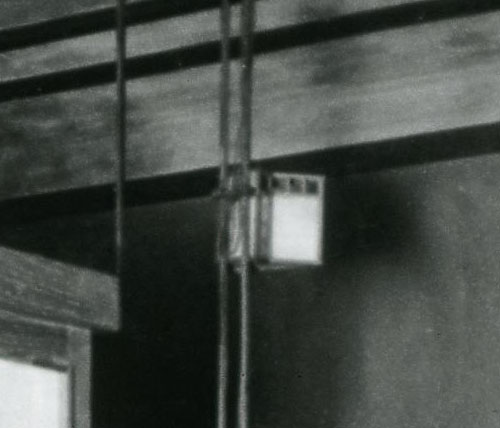 |
|
13d: Detail of Image #6:
View of Cove. A fifth version (E) would be the
possible small square fixture attached above Version
B, possibly added at a later time for addition light
in the cove. |
|
|
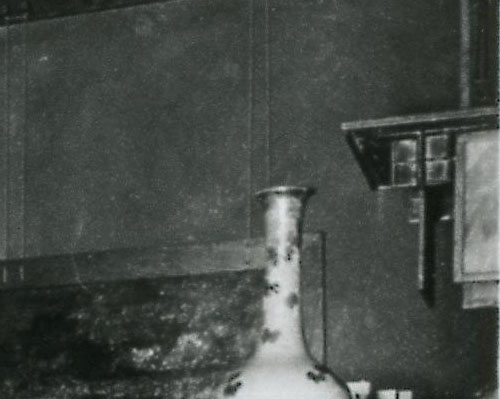 |
|
13a: Detail of Image #6:
View of Cove. Version A is partially visible
on the top right. |
|
|
|
Version C |
 |
|
14a: Image #7: View
toward fireplace. Version C, top left, is a rectangle fixture
that is suspended. The sides match the
dimensions of the corner pieces, but run in a parallel line
between the two corners, similar to Version
B. A square piece is on either end like
Version A. |
| |
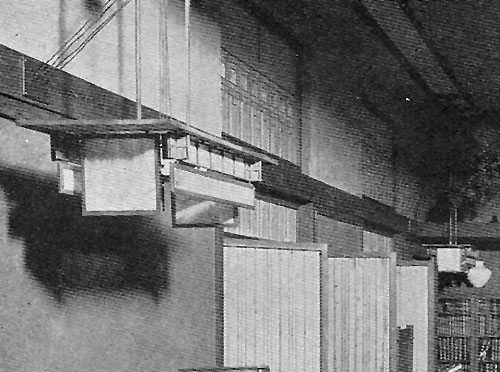 |
|
14b: Detail of Image #7:
Version C, top left, is a rectangle fixture
that is suspended. The sides match the
dimensions of the corner pieces, but run in a parallel line
between the two corners, similar to Version
B. A square piece is on either end like
Version A. |
|
|
|
Version D |
 |
|
15a: Image #6: View of
Cove. Version D can clearly be seen at the
top of the book shelf pier. Publisher's
Weekly reported "By a unique system of shelf-lighting,
the title of every volume from top shelf to
bottom were easily be read, while at the same
time the lights were hidden from the eye".
The book tier on the left shows the design of
the lighting system just above the top shelf. Not
only were the upper shelves recessed, but the
lower shelves were slightly slanted, angling the
books upward. |
|
|
 |
|
15b: Detail of Image #6:
View of Cove. Version D can clearly be seen
at the top of the book shelf pier. Publisher's
Weekly reported "By a unique system of shelf-lighting,
the title of every volume from top shelf to
bottom were easily be read, while at the same
time the lights were hidden from the eye".
The book tier on the left shows the design of
the lighting system just above the top shelf. Not
only were the upper shelves recessed, but the
lower shelves were slightly slanted, angling the
books upward. |
|
|
 |
|
15c: Detail of Image #6:
View of Cove. Version D can clearly be seen at the
top of the book shelf pier. |
|
|
|
|
|
|
|
Footnote |
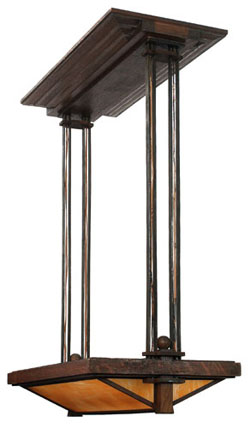 |
During our research, ran
across this lamp that was sold at the Treadway
Toomey Auction, on May 23, 2004. It was identified as
a lamp from Browne's Bookstore. It sold for
$19,975. We could find no evidence that it was in
the first Wright designed Brown's Bookstore on the seventh floor. It
could not have been in the coves seeing that the
ceiling was slanted. It possibly could have been
from the second store on the first floor, but Wright
was not involved in designing the second. |
|
|
|
|
|
|
|
|
Text and illustrations Copyright Douglas
M. Steiner unless otherwise noted. |
|
|
|
|
|
|
Back |
|
|
|
|
|
|

CLICK TO ORDER
1a: The first example is image #3, in the seating cove. "...looking out on the clear waters of Lake Michigan through an atmosphere, slightly smoked." Wright utilized the three existing sets of windows, each set consisting of seven repeated vertical designs. In each set, Wright continued the design from glass panel to glass panel, even allowing sections to open. Hidden behind the circular urn on the right are the additional side windows.
